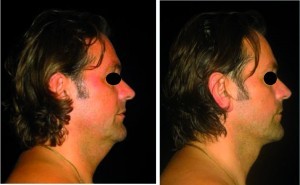Postoperative procedure
A manual lymphatic draining massage is immediately administered while the patient is still on the operating table. It will be repeated at a frequency of three per week for 2 weeks. A compressive dressing will be put in place for 24 hours.
It is not mandatory, but the author recommends that the patient wears a chin garment when he/she is at home (but not at night) to avoid secondary folds at the chin garment level. Classic antibiotics are prescribed for 8 days, as well as anti-oedematous medication.
Complications
Benign complications include oedema that may last for between 2 and 6 days; ecchymosis, which will usually be moderate and mostly located in the under clavicle area; pain is minimal, and usually more of
a discomfort.
However, there are a number of more serious side‑effects and complications that the physician should be aware of:
- Facial nerve damage: pay particular attention to the lower maxilla
- Haematoma (though this is rare)
- Complications as pertaining to any surgical act
- Mandible branch of the facial nerve: lesions may bring about a deformity, especially when one smiles. This is owing to the proximity of the artery and facial vein, which explains the risk of bleeding at the time of cauterisation at this level.
Some authors have warned that even with a foam cannula, the back and forth movements may induce a demyelination of the nervous sheath, causing momentary problems with facial mimicry expression that can last for a few weeks.
With regard to excessive aspiration with a classic cannula, the medical literature describes:
- Insufficient results linked to a bad indication or technical inadequacy
- Pigmentations that, without sun exposure, gradually disappear
- Dimples or furrows as a result of too incisive or superficial cannulation
- Transitory paresis, mostly at the cervical branch level, changing oral movements, but disappearing after approximately 6 weeks
- Haematoma
- Infection.

Figure 3. 43-year-old male patient (left) before and (right) after liposculpture of the neck and jowl line
Further to neck fat aspiration, some platysmal chords can appear; however, they were present before the intervention but hidden under the fat. These chords can be treated using botulinum toxin injections or partial sectioning according to Fournier’s technique5. Treatment with botulinum toxin should see 10 units per chord, with 2 units per point. Be aware of a risk of dysphagia.
Discussion
Non-aspirated cannulation obtains a cicatricial fibrous tissue and a cutaneous retraction that allows the redefinition of the oval of the face. This cannulation must be strictly carried out within the fatty tissue in order to induce a fat-on-fat scarring process:
- First step: deep cannulation
- Second step: superficial cannulation, guaranteeing a good cutaneous retraction.
Results will show a 20% reduction of fat after 10 days; 50% after 3 weeks; 80% after 2 months; and 100% after 6 months.
Like neurones, adipocytes do not multiply (they simply shrink or grow); these are the only two kinds of cells that do not have cellular multiplication ability.
If this is regrettable as far as neurones are concerned, it is quite beneficial with regard to adipocytes. During the slimming process, the volume of the cells decreases, which explains the effects of ‘yo-yo’ dieing: women in particular will regularly lose weight and then put it back on. During a lipoplasty surgical intervention, the number of adipocytes decreases, and for this reason the intervention is definitive. Furthermore, the skin does not sag after the intervention, but retracts, easily covering the maxilla without excess.
Fibrosis is inevitably a consequence of superficial cannulation and consequently cutaneous reaction, even when there is almost no presence of fat in emaciated faces. According to Illouz6, the scarring fibrosis induced by cannulation is as important as the uplift or separation during a lifting.



